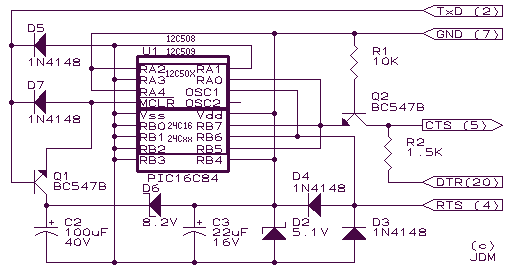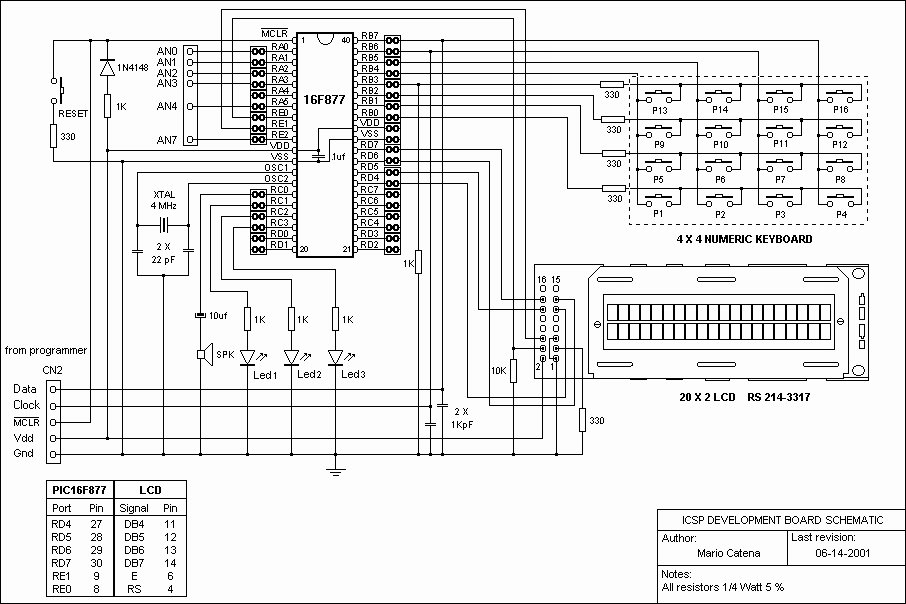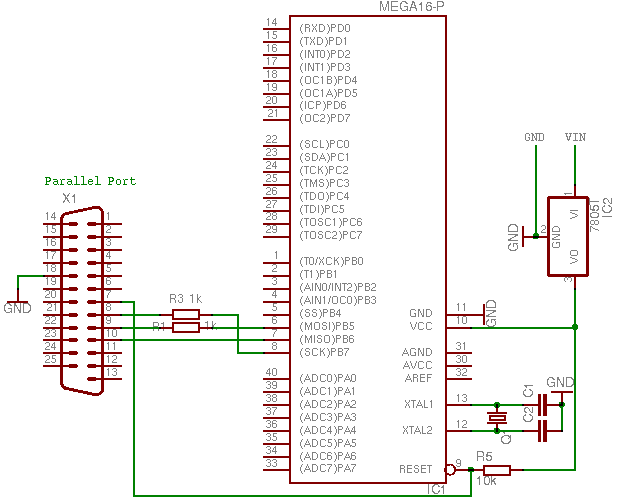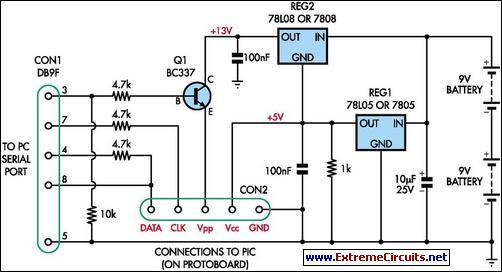
Universal PIC-EEPROM programmer

This is a JENS MADSEN project I've built to program my PIC and EEPROM (16xXXX AND 12CXXX AND 24CXX). I use it with IC-Prog; it is little, simple to build, cheap, and gives few bugs. More: When I built it, at first it seemed not to work properly (read but not write); then I made the following modification to the schematic: added a 1 k resistor in series on the RTS line, and now everything is okay.
The described project is a programming interface designed for Microchip's PIC microcontrollers and EEPROM devices, specifically the 16xXXX, 12CXXX, and 24CXX series. The circuit is compact, emphasizing ease of assembly and cost-effectiveness, making it accessible for hobbyists and professionals alike.
The primary function of this device is to facilitate the programming of EEPROMs and microcontrollers via a serial interface, commonly using software like IC-Prog. The circuit likely includes a microcontroller or a dedicated programming IC that interfaces with the target EEPROM or PIC device to perform read and write operations.
A notable modification was made to the original design, which involved adding a 1 kΩ resistor in series with the RTS (Request to Send) line. This adjustment suggests that the RTS line was experiencing issues that affected the programming operation, particularly in writing data to the target devices. By introducing the resistor, the signal integrity on the RTS line was improved, allowing for successful communication and programming.
The overall design may consist of a few essential components: a microcontroller, voltage level shifters (if interfacing with different logic levels), decoupling capacitors for power supply stability, and possibly a USB or RS-232 interface for connecting to a computer. The schematic would typically illustrate how these components interconnect, including the power supply arrangement, signal paths, and any additional features such as LED indicators for status monitoring.
In summary, the project serves as a practical solution for programming Microchip devices, with a straightforward design that can be adapted based on user experience and feedback. The modification made enhances its reliability, ensuring that it meets the necessary operational requirements for effective device programming.This is a JENS MADSEN `S project I`ve built to program my pic and EEPROM (16xXXX AND 12CXXX AND 24CXX) I use it with ic-prog , it is little ,simply to build ,cheap and give few bugs. When I built it , At first it seems not to work properly (read but not write) then I made the following mod to the schematic: added a 1 k resistor in series on rts line and now everything is ok.! 🔗 External reference
The described project is a programming interface designed for Microchip's PIC microcontrollers and EEPROM devices, specifically the 16xXXX, 12CXXX, and 24CXX series. The circuit is compact, emphasizing ease of assembly and cost-effectiveness, making it accessible for hobbyists and professionals alike.
The primary function of this device is to facilitate the programming of EEPROMs and microcontrollers via a serial interface, commonly using software like IC-Prog. The circuit likely includes a microcontroller or a dedicated programming IC that interfaces with the target EEPROM or PIC device to perform read and write operations.
A notable modification was made to the original design, which involved adding a 1 kΩ resistor in series with the RTS (Request to Send) line. This adjustment suggests that the RTS line was experiencing issues that affected the programming operation, particularly in writing data to the target devices. By introducing the resistor, the signal integrity on the RTS line was improved, allowing for successful communication and programming.
The overall design may consist of a few essential components: a microcontroller, voltage level shifters (if interfacing with different logic levels), decoupling capacitors for power supply stability, and possibly a USB or RS-232 interface for connecting to a computer. The schematic would typically illustrate how these components interconnect, including the power supply arrangement, signal paths, and any additional features such as LED indicators for status monitoring.
In summary, the project serves as a practical solution for programming Microchip devices, with a straightforward design that can be adapted based on user experience and feedback. The modification made enhances its reliability, ensuring that it meets the necessary operational requirements for effective device programming.This is a JENS MADSEN `S project I`ve built to program my pic and EEPROM (16xXXX AND 12CXXX AND 24CXX) I use it with ic-prog , it is little ,simply to build ,cheap and give few bugs. When I built it , At first it seems not to work properly (read but not write) then I made the following mod to the schematic: added a 1 k resistor in series on rts line and now everything is ok.! 🔗 External reference





